 | |||
 |
 |  | |
 |  | ||
 |  | ||
 |  | ||
 |  | ||

| Please Read: How to Help Our Site at No Cost to You - Some of our articles contain recommendations for products we like and vendors we personally trust. Some of those vendors may pay us a very small commission if you click on a link and buy their products. This costs you nothing at all and helps offset the costs of what we do. So if we point you to something you decide to buy later, please make certain you come back through our site and click on the link directly. Thanks. |


|
Decking the NEW New Boston and Donnels Creek RR, Part 2This is a followup to our article "Framing the NEW New Boston and Donnels Creek RR, Part 2". These articles have been written in conjunction with other construction and planning articles that tell the story of our "new" railroad in chronological sequence, beginning with planning efforts in early 2017.
Then I started the decking, which will run perpendicular to the frame. But I ran out of lumber quickly. Back to the store.
As mentioned in the article Framing the NEW New Boston and Donnels Creek RR, Part 3", I had determined that ground-rated 2"x6" boards would give me the most robust decking solution. As a result, my platforms look a lot like decks before I line them with vinyl sheeting, attach a border, and dump gravel and dirt on them. Once again, if you plan to use typical 5/4" decking boards for this part of the project, your frame boards should be 16" apart or less. In some parts of the country, this will save you some money, but I can't get ground-rated 5/4" boards around here, so 2"x6" it is. If you've been following all along, the content of this article will seem familiar. Why? Because the platforms I built in 2017 have worked out exactly how I hoped they would - something that almost never happens for me. They are stable and very easy to maintain, and most of the plants I selected for them are filling in nicely. So I'm going to keep going the way I have been unless something even better occurs. Allowing for TrimmingAs I ran the decking, I let it stick out a few inches extra, so I could smooth it to the final shape with a simple saw cut. This is especially important on the diagonal parts, as you can see in oval on the right side of the following photo. Also, I wasn't too picky about how far the boards protruded under the upper platform, shown in the oval on the left side of the photo. Those ends will be hidden once I trim out the gap between platforms, and it's not like anyone will be standing there. TrimmingAs I mentioned many chapters ago, I deliberately chose odd angles because I wanted the railroad to feel more "organic" than simple geometric shapes would have allowed. The frame for this platform more-or-less echoed the shape of the platform above it, and I could have simply followed that outline. But I chose instead to have a slightly different shape, so I added a dull "point" at the very front.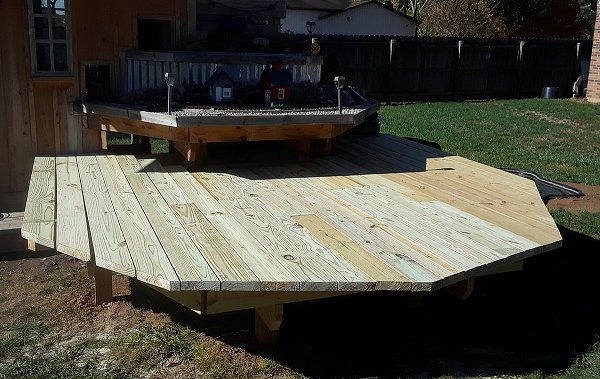 Getting Ready for DirtscapingEven though this lumber is technically rated for constant ground contact, I want to protect it a little, and to keep my dirt and gravel from falling between the cracks. So I stapled sheet vinyl over it and trimmed the edges. Yes, you've seen this before, too. As mentioned earlier, the vinyl is from a company that buys up used billboard vinyl and repackages it so it only costs a few cents per square foot. Both orders I've received were misprints that were never used, so that's even better, but your mileage may vary.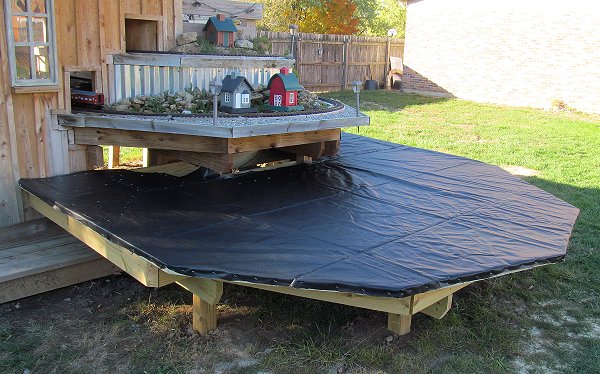 By the way, it doesn't matter if there are holes or if the patching is "patchy," since I have to poke holes in it for drainage anyway. Next, I installed trim boards around the edges. These are pressure-treated fencing boards, split in half lengthwise. I fasten them so that the bottom edge is flush with the bottom edge of the decking material. 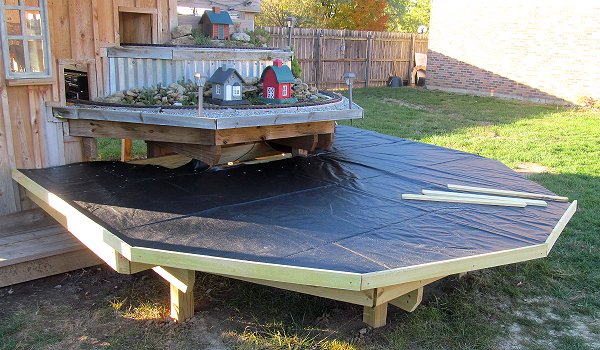 That allows the top edge to protrude about an inch or so, enough to keep my gravel from pouring over the edge. Full disclosure: this material is not ground-rated, and it does break down in a few years if it's exposed to contant moisture. Since I'm only using pea gravel near it at this time, I hope it will hold up longer.  In many of our photos you can see that this material on the parts we installed in 2017 grayed up so quickly that it's barely noticeable once it's installed. Railroad gardener extroardinaire Paul Busse once told me that the railroad ties he liked to use were so "ubiquitous" that people barely noticed once their attention was drawn to the trains and accessories. The same thing is true of those landscaping blocks many people use. Filling the GapsBack in 2017, I used corrugated steel panels to fill the vertical gap between the top two layers. I had researched several other materials, but they would have been cost-prohibitive, and I had the steel panels left over from another project.At the time, I was thinking of making the whole railroad even more rustic than it wound up being. But the truth is, the steel panels blended right in, and I doubt anyone noticed them once I had dirt, rocks, plants, buildings, and trains in place. As it turned out, the "weather clock" was ticking on this project and I wanted to get something into the vertical gap between the new layer and the middle layer. I calculated that I had just enough of the corrugated steel left over to fill that gap as well. (I know, the "realists" are cringing," but it really does fade into the background once everything else is installed). The steel needs to be fastened top and bottom, so I cut three pieces of scrap lumber and aligned them directly under the frame pieces above them. That way, when I cut the sheet metal into strips I could screw it in place. 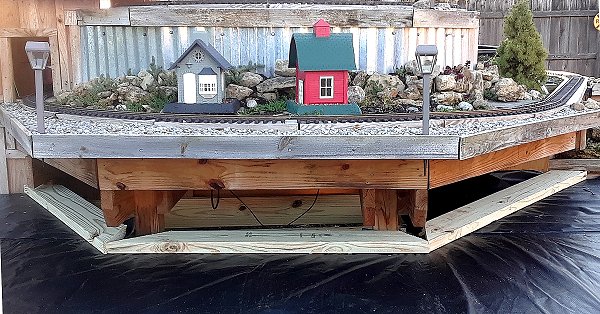 By the way, the electrical cords you see hanging down in the photo above are for lighting I have yet to install on the top two layers. They run between the platforms and the shed, tied in knots at both ends so I can fish them out and hook them up whever I don't have something more pressing to do. This "plan ahead" example is brought to you by a person who has done a lifetime's worth of crawling around to run, bury, and re-run 12-volt wiring in a previous life. The distance between the platforms varies a little here and there. Even though I cut each sheet as wide as it could be to fit where it needed to go, I had to leave gaps somewhere. The top edge would be visible, so I kept the steel as flush as possible there and left the gaps on the lower edge where they will eventually be covered with rocks and dirt.  ConclusionAs of this publication, it is almost November and there is no way I will have this layer completely "dirtscaped" before the snows come. On top of that, I have a Christmas-themed "open railroad in about two weeks (Nov. 16, 2019 - if you're anywhere near Springfield OH, contact me for times and directions. So this is the last outdoor construction project for this railroad this year. Considering I couldn't get started until my most recent consulting contract ran out on August 31, I don't think I did too badly, installing an in-ground pond, completing the waterfall, and building this platform. And now, when I tell people that I plan to have the lower platform continue on the other side of the pond with another train running through the shed and across the waterfall, some of them will be able to picture it. For now my "short-term" plan for this platform has to do with getting it ready for the open railroad. I plan to put some rocks, a few buildings and a loop or two of track in it, set straight in pea gravel for now, and get on with the Christmas decorations, etc. Stay tuned. Keep in TouchFinally, please let us know about your ongoing projects. Ask questions, send corrections, suggest article ideas, send photos, whatever you think will help you or your fellow railroaders. In the meantime, enjoy your trains, and especially enjoy any time you have with your family in the coming weeks, Paul Race
Click on the following link to see our progress of mid-November, 2019.
Click on the following link to see our progress of early October, 2019.
Click on the photo to see our plans for the next addition, as of late September, 2019.
The process included checking the pump, extending the hoses, rescuing toads, building the platform, trimming the platform, testing the pool's location, etc. Click the photo to go to the article.
Click on the photo to see our progress as of mid-September, 2019.
Click on the photo to see a lot of last-minute preparations and some photos of the November 10, 2018 event itself.
By the way, going over lumber receipts in early 2019, I couldn't believe I was still siding the train shed in late October, and managed to have an open railroad in mid-November. It is a little crazy how fast things can go together if you have a deadline and a lot of gift cards. Click on the photo to see our progress as of late October, 2018.
Includes choosing the siding and windows, installing the door, painting the windowframes, and adding crosspieces to support the vertical siding boards.
Now the roof is waterproof enough to get us through the next couple of months at least, maybe more.
I thought about bringing in helpers for this part, but a reader commented on how helpful it was to see how one person could do this sort of thing by himself, so I just kept plugging away. Click on the photo to see our progress as of September 13, 2018
Click on the photo to see our status as of August 5, 2018.
The way we got the rafters and ridge board up wouldn't work for everybody, but it worked for us, and hopefully will help other folks to "think outside the box" - literally in this case. Click on the photo to see our progress as of July 14, 2018.
Click on the photo to see our status as of July 9, 2018.
Click on the photo to see our progress as of June 13, 2018.
Click on the photo to see our status as of June 1, 2018.
Click on the photo to see our status as of February 20, 2018
Click on the photo to see our status as of February 20, 2018
Click on the photo to see our status as of November 21, 2017
Click on the photo to see our status as of October 25, 2017
Click on the photo to see our status as of October 15, 2017
Click on the photo to see our status as of October, 10, 2017
Click on the photo to see our status as of September 26, 2017
Click on the photo to see our status as of September 17, 2017
Click on the photo to see our status as of September 7, 2017
Click on the photo to see our status as of August 10, 2017
Click on the photo to see our status as of the end of July, 2017
Click on the photo to see what we were considering as of late May, 2017
Click on the photo to see what we were considering as of late April, 2017
Click on the photo to see what we were considering in early April, 2017
Click on the photo to see what we were considering in March, 2017
Click on the photo to see the home page of Paul's railroad.
To read more, or to look at recommended Garden Railroading and Big Indoor Train products, please click on the index pages below.
|
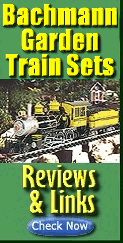
 
|
Note: Family Garden TrainsTM, Garden Train StoreTM, Big Christmas TrainsTM, BIG Indoor TrainsTM, and BIG Train StoreTM are trademarks of
Breakthrough Communications (btcomm.com). All information, data, text, and illustrations on this web site are
Copyright (c) 1999, 2000, 2001, 2002, 2003, 2004, 2005, 2006, 2007, 2008, 2009, 2010, 2011, 2012, 2013, 2014, 2015, 2016, 2017, 2018, 2019 by
Paul D. Race. Reuse or republication without prior written permission is specifically
forbidden.
Family Garden Trains is a participant in the Amazon Services LLC Associates Program,
an affiliate advertising program designed to provide a means for sites to earn advertising
fees by advertising and linking to amazon.com.
For more information, please contact us
 |  |
| Visit related pages and affiliated sites: | |||||
| - Trains and Hobbies - | |||||
 |  |
 |
 |
 |  |
 |

|

|  |
 |

|
| - Christmas Memories and Collectibles - | |||||
 |

|
 |

|
 |

|
| - Family Activities and Crafts - | |||||
 |

|

|

|

|

|
| - Music - | |||||

|
 |
 |

|

|

|

|

|

|

|

|

|

|

|

|

|

|

|

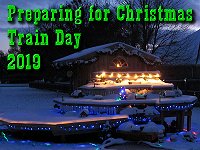 Proceed to "Preparing for Christmas Train Day 2019"
Proceed to "Preparing for Christmas Train Day 2019" Return to "Framing the NEW New Boston and Donnels Creek RR - Part 7"
Return to "Framing the NEW New Boston and Donnels Creek RR - Part 7" Return to "Planning the NEW New Boston and Donnels Creek RR - Part 5"
Return to "Planning the NEW New Boston and Donnels Creek RR - Part 5" Return to Waterscaping Part 4.
Return to Waterscaping Part 4. Return to "Waterscaping, Part 3"
Return to "Waterscaping, Part 3"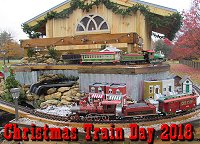 Return to Christmas Train Day, 2018
Return to Christmas Train Day, 2018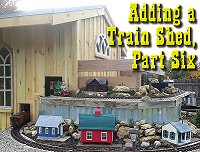 Return to "Adding a Train Shed Part 6"
Return to "Adding a Train Shed Part 6"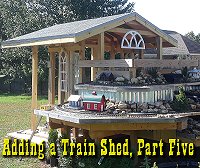 Return to "Adding a Train Shed Part 5"
Return to "Adding a Train Shed Part 5"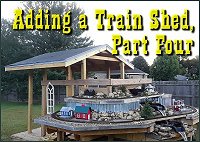 Return to "Adding a Train Shed Part 4"
Return to "Adding a Train Shed Part 4"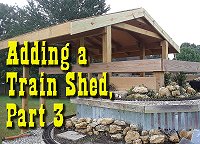 Return to "Adding a Train Shed Part 3"
Return to "Adding a Train Shed Part 3"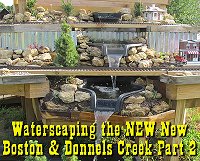 Return to "Waterscaping Part 2"
Return to "Waterscaping Part 2"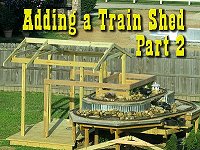 Return to "Adding a Train Shed Part 2"
Return to "Adding a Train Shed Part 2" Return to "Adding a Train Shed Part 1"
Return to "Adding a Train Shed Part 1"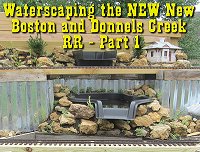 Return to "Waterscaping the NEW New Boston and Donnels Creek Part 1,"
Return to "Waterscaping the NEW New Boston and Donnels Creek Part 1,"  Return to "Dirtscaping the NEW New Boston and Donnels Creek RR, Part 2.
Return to "Dirtscaping the NEW New Boston and Donnels Creek RR, Part 2. Return to "Adding Raised Roadbed to the NEW New Boston and Donnels Creek, Part 2"
Return to "Adding Raised Roadbed to the NEW New Boston and Donnels Creek, Part 2"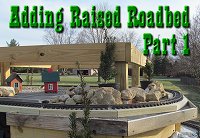 Return to "Adding Raised Roadbed to the NEW New Boston and Donnels Creek RR, Part 1"
Return to "Adding Raised Roadbed to the NEW New Boston and Donnels Creek RR, Part 1" Return to "2018: Springing into Spring on the NEW New Boston & Donnels Creek RR."
Return to "2018: Springing into Spring on the NEW New Boston & Donnels Creek RR."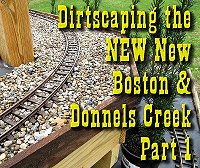 Return to "Dirtscaping the NEW New Boston and Donnels Creek RR, Part 1.
Return to "Dirtscaping the NEW New Boston and Donnels Creek RR, Part 1.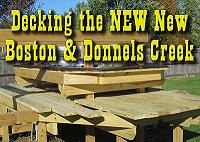 Return to "Decking the NEW New Boston and Donnels Creek RR
Return to "Decking the NEW New Boston and Donnels Creek RR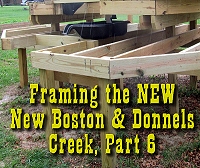 Return to "Framing the NEW New Boston and Donnels Creek RR, Part 6"
Return to "Framing the NEW New Boston and Donnels Creek RR, Part 6"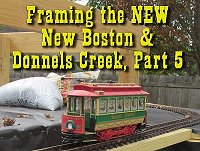 Return to "Framing the NEW New Boston and Donnels Creek RR, Part 5"
Return to "Framing the NEW New Boston and Donnels Creek RR, Part 5"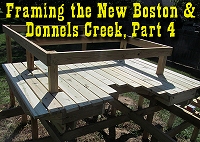 Return to "Framing the NEW New Boston and Donnels Creek RR, Part 4"
Return to "Framing the NEW New Boston and Donnels Creek RR, Part 4" Return to "Framing the NEW New Boston and Donnels Creek RR, Part 3"
Return to "Framing the NEW New Boston and Donnels Creek RR, Part 3" Return to "Framing the NEW New Boston and Donnels Creek RR, Part 2"
Return to "Framing the NEW New Boston and Donnels Creek RR, Part 2" Return to "Framing the NEW New Boston and Donnels Creek RR, Part 1"
Return to "Framing the NEW New Boston and Donnels Creek RR, Part 1" Return to "Breaking Ground on the NEW New Boston and Donnels Creek"
Return to "Breaking Ground on the NEW New Boston and Donnels Creek"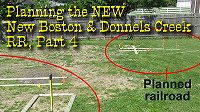 Return to "Planning the NEW New Boston and Donnels Creek, Part 4"
Return to "Planning the NEW New Boston and Donnels Creek, Part 4" Return to "Planning the NEW New Boston and Donnels Creek, Part 3"
Return to "Planning the NEW New Boston and Donnels Creek, Part 3" Return to "Planning the NEW New Boston and Donnels Creek, Part 2"
Return to "Planning the NEW New Boston and Donnels Creek, Part 2" Return to "Planning the NEW New Boston and Donnels Creek, Part 1"
Return to "Planning the NEW New Boston and Donnels Creek, Part 1"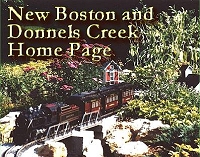 Return to the New Boston and Donnels Creek RR Page
Return to the New Boston and Donnels Creek RR Page Return to Family Garden Trains' Home Page
Return to Family Garden Trains' Home Page